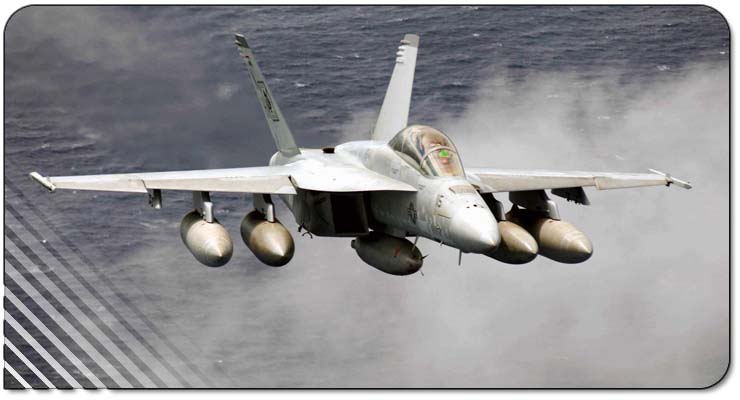Description:
All-weather fighter and
attack aircraft. The
single-seat F/A-18 Hornet is the nation's first strike-fighter. It was
designed for traditional strike applications such as interdiction and
close air support without compromising its fighter capabilities. With
its excellent fighter and self-defense capabilities, the F/A-18 at the
same time increases strike mission survivability and supplements the
F-14 Tomcat in fleet air defense. F/A-18 Hornets are currently
operating in 37 tactical squadrons from air stations world-wide, and
from 10 aircraft carriers. The U.S. Navy's Blue Angels Flight
Demonstration Squadron proudly flies them. The Hornet comprises the
aviation strike force for seven foreign customers including Canada,
Australia, Finland, Kuwait, Malaysia, Spain and Switzerland.
The
newest model, Super Hornet, is highly capable across the full mission
spectrum: air superiority, fighter escort, reconnaissance, aerial
refueling, close air support, air defense suppression and day/night
precision strike. Compared to the original F/A-18 A through D models,
Super Hornet has longer range, an aerial refueling capability,
increased survivability/lethality and improved carrier suitability.
[Capability of precision-guided munitions: JDAM (all variants) and
JSOW. JASSM in the future]
Features
The
F/A-18 Hornet, an all-weather aircraft, is used as an attack aircraft
as well as a fighter. In its fighter mode, the F/A-18 is used primarily
as a fighter escort and for fleet air defense; in its attack mode, it
is used for force projection, interdiction and close and deep air
support.
Background
The
F/A-18 demonstrated its capabilities and versatility during Operation
Desert Storm, shooting down enemy fighters and subsequently bombing
enemy targets with the same aircraft on the same mission, and breaking
all records for tactical aircraft in availability, reliability, and
maintainability.
Hornets taking direct hits from surface-to-air
missiles, recovering successfully, being repaired quickly, and flying
again the next day proved the aircraft's survivability. The F/A-18 is a
twin engine, mid-wing, multi-mission tactical aircraft. The F/A-18A and
C are single seat aircraft. The F/A-18B and D are dual-seaters. The B
model is used primarily for training, while the D model is the current
Navy aircraft for attack, tactical air control, forward air control and
reconnaissance squadrons. The newest models, the E and F were rolled
out at McDonnell Douglas Sept. 17, 1995. The E is a single seat while
the F is a two-seater.
The F/A-18 E/F acquisition program was an
unparalleled success. The aircraft emerged from Engineering and
Manufacturing Development meeting all of its performance requirements
on cost, on schedule and 400 pounds under weight. All of this was
verified in Operational Verification testing, the final exam, passing
with flying colors receiving the highest possible endorsement.
The
first operational cruise of Super Hornet, F/A-18 E, was with VFA-115
onboard the USS Abraham Lincoln (CVN 72) on July 24, 2002, and saw
initial combat action on Nov. 6, 2002, when they participated in a
strike on hostile targets in the "no-fly" zone in Iraq.
Super
Hornet, flew combat sorties from Abraham Lincoln during Southern Watch,
demonstrating reliability and an increased range and payload
capability. VFA 115 embarked aboard Lincoln expended twice the amount
of bombs as other squadrons in their airwing (with 100% accuracy) and
met and exceeded all readiness requirements while on deployment. The
Super Hornet cost per flight hour is 40% of the F-14 Tomcat and
requires 75% less labor hours per flight hour.
All F/A-18s can
be configured quickly to perform either fighter or attack roles or
both, through selected use of external equipment to accomplish specific
missions. This "force multiplier" capability gives the operational
commander more flexibility in employing tactical aircraft in a rapidly
changing battle scenario. The fighter missions are primarily fighter
escort and fleet air defense; while the attack missions are force
projection, interdiction, and close and deep air support.
The
F/A-18C and D models are the result of a block upgrade in 1987
incorporating provisions for employing updated missiles and jamming
devices against enemy ordnance. C and D models delivered since 1989
also include an improved night attack capability. The E and F models
have built on the proven effectiveness of the A through D aircraft. The
Super Hornet provides aircrew the capability and performance necessary
to face 21st century threats. |
WEFT Description
-
- WINGS
- ENGINE
- FUSELAGE
- TAIL
|
|

